According to reports I’ve received, the 105 CTi is still a work in progress. By that, I don’t mean that any major overhaul is being considered—only that Remington may still be doing a little tweaking here and there that won’t dramatically alter the design. That tweaking is to be expected on a design that differs so markedly from other Remington gas-operated shotguns. For one thing, 105 CTi ejects spent hulls downward from the titanium receiver rather than sideways.
Another not-so-noticeable difference is an object identified as a “rate controller,” hidden within the stock. The closest thing to this part on the familiar Model 1100 or 1187 would be the action spring. The rate controller serves as a seat for the tail of the bolt-slide assembly, and does everything an action spring does. Plus, I’m told, it soaks up some recoil. In addition, felt recoil is
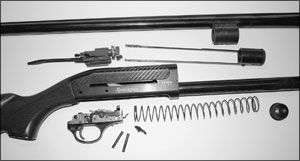
300
reduced by the combination of a new optimized gas system, an over-bored barrel, a lengthened forcing cone, and a new convex recoil pad. Taken together, this makes 105 CTi the lightest, softest-shooting 12 gauge that Remington has ever produced.
In operation, once the bolt has opened fully on the 105, the carrier pivots down to eject the hull and pick up a fresh round from the magazine. Then it pivots upward to position the shell in front of the bolt. The bolt closes to chamber the round, unless that round is the last one in the magazine. In that case, the action locks open. Conversely, with the Model 1100 and 1187, fully opening the bolt ejects the hull from the receiver’s upper ejection port, lowers the carrier to pick up the next shell from the magazine, and raises the shell on the carrier for chambering when the bolt is released. And on the 1100-Series shotguns, the action closes after the last round is fired.
With the 105, something wonderful happens after cocking the gun, inserting a shell into the magazine tube via the bottom-loading port, and sliding the thumb down and out of the receiver. The carrier raises and the round is chambered automatically. The magazine can then be loaded with up to four additional rounds of the same size by pushing them into the mag tube one at a time, making sure each shell engages the feed latch to hold it in the tube.
If this feature offends a traditionalist, the 105 can be charged like its less sophisticated cousins. By that, I mean close the bolt by pulling the bolt and bolt release to the rear simultaneously, insert the shells into the magazine tube, lock the bolt open, and press the bolt release and let the operating handle move forward to chamber the initial round.
Basic Disassembly
For obvious reasons, the oils and solvents mentioned in the owner’s manual all bear the Remington name. But, of course, the shotgun’s owner probably won’t bring you the manual along with the gun. So you don’t have to limit yourself to the Remington brand. For example, the manual advises the use of Rem Oil on the outside of the magazine tube after it has been cleared of fouling and air dried. Personally, I like Elmer’s Slide-All with Teflon as a lubricant between magazine tubes and their associated springs, which seems to do a good job of discouraging residue buildup.
Now, to begin the disassembly, put on your safety glasses and make sure the gun is empty. Then pull the operating handle and bolt release to the rear. Slowly allow the bolt to close. Turn the magazine cap counter-clockwise to remove it, and then slide the forend off to the front. Grasp the barrel ahead of the gas cylinder and pull it from the receiver. After starting the trigger-assembly pins out, push them completely from the receiver with a parallel-sided drift. Remove the trigger assembly downward.
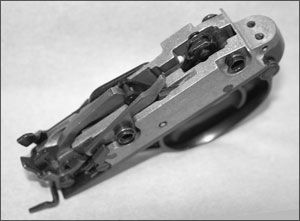
300
Now, with the bolt still closed, give the operating handle a quarter turn counter-clockwise and pull it free. Insert your thumb into the bottom of the receiver. Push the bolt upward as you slide it and the action-sleeve assembly out of the receiver as a unit. Now slip the action spring off the magazine tube. Carefully spread apart the action bars to remove them from the bolt assembly. The action-sleeve seal and inner seal can be cleaned where they sit with a soft brush and some solvent. If you removed them, or they come off in the cleaning process, I hope you paid attention to their original location so you can get them properly reinstalled.
Detailed Disassembly
To disassemble the bolt, compress the firing pin (#16) with your thumb and pull out its retaining cotter pin (#17). Ease the pressure on the firing pin and remove it from the assembly. Slip the firing-pin spring (#18) off the pin. Invert the bolt assembly and tap it on the bottom until the bolt-cam pin (#5) can be removed. Separate the bolt head (#6) from the locking ring (#26). To clean all these elements, spray them with solvent and brush if necessary to remove all residue. Wipe and air dry before applying a light coat of gun oil.
The trigger assembly is officially called “the firing mechanism” or “fire-control system” and is officially “not yet approved for gun-shop repair.” That also means you can’t buy parts for it. You can buy a complete replacement assembly, but parts? No way, no how. And with the possible exception of a couple of wire retaining clips, the trigger assembly on the 105 CTi doesn’t remotely resemble the assemblies of the 1100 or 1187. Sure, an experienced gunsmith could figure out how to take it apart, but why bother? If a damaged piece were to be discovered, a whole new assembly would have to be ordered anyway. So this begs for an answer to a serious question: Since we’re not allowed to take it apart, and since trigger assemblies are prone to attract dirt and debris in any shotgun, how can we detail clean it?
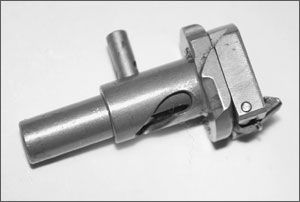
300
Answer: Look at the accompanying photo and reach for an aerosol can of gun-action cleaner. Spray it into the assembly at all the points indicated, paying particular attention to the actuator. Even better, immerse the entire group in a bucket of PolyDunk. In case you missed our report on it a while back, PolyDunk is a top-notch cleaning compound available from Cylinder & Slide (402/721-4277). After spraying or dunking, air dry the unit before applying a light coating of lubrication at the same locations shown for cleaning.
A Few Words from the Soapbox
Let me change the subject for a few paragraphs to discuss this policy of “not approved for gun-shop repair.” This legal-department ass-covering policy is not exclusive to Remington; in fact, it’s spreading through the industry. Some manufacturers—Smith & Wesson comes immediately to mind—have carried litigation concerns so far as to eliminate the schematic drawings from their owner’s manuals. Frankly, it doesn’t matter what’s eliminated or what wording is added; gun buyers have a habit of taking brand-new firearms out of their boxes and taking them apart to “make improvements”—even before firing them. That’s why we have so many gun owners coming in our doors with plastic bags full of parts and pleas to “put it back together.”
Putting it back together—and putting it back together properly—was one of the primary reasons why this monthly series of disassembly/reassembly articles was initiated almost 15 years ago. In all that time, not one of those articles has been mentioned, let alone involved, in a law suit. There’s a reason for it. None of them have described taking a firearm down or reassembling it in any manner other than that practiced by factory repair personnel.
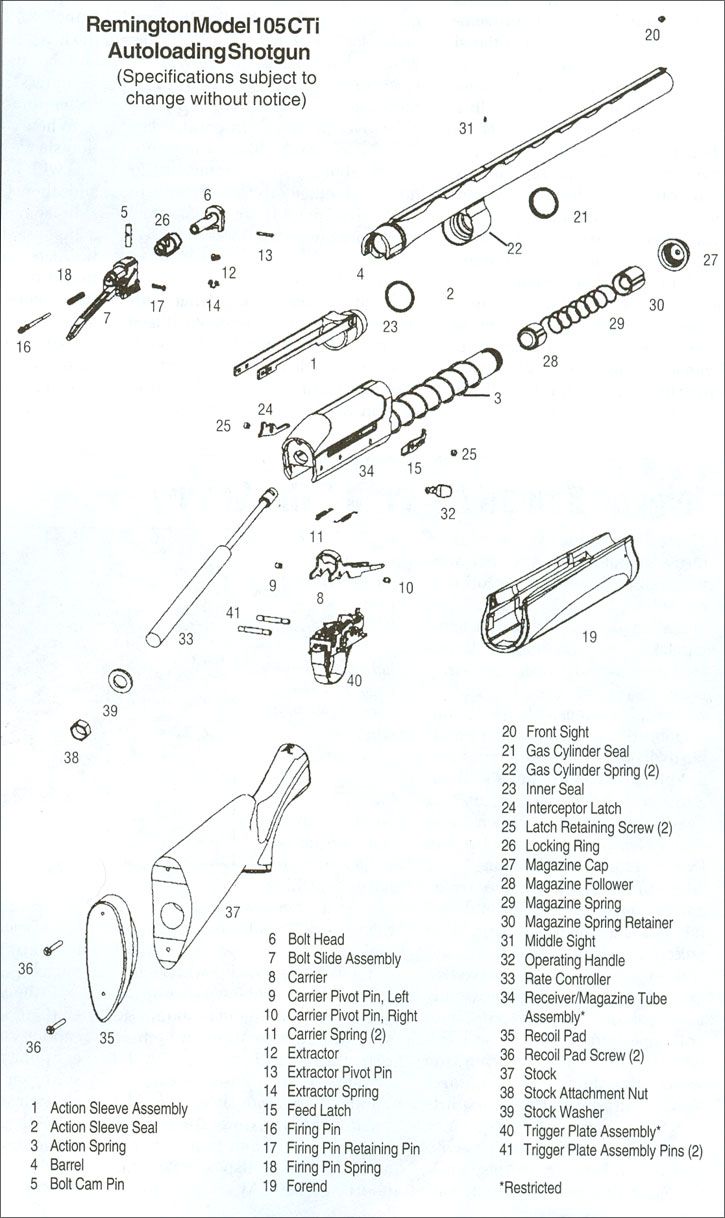
700
As a result, it grinds my gizzard when I see statements like “not approved for gun-shop repair.” Even worse perhaps are the prohibitions on schematic drawings, which make it difficult for the dedicated and careful gunsmiths who make a living by keeping firearms functioning reliably and safely.
Many years ago, I asked the corporate attorney for a leading firearm manufacturer if he thought it was wise for this magazine to follow factory-only practices in our reporting. His response was: “Wise? Hell, it’ll probably save me weeks in court every year.” It seems to me that not only allowing but assisting the gunsmith to do his job efficiently and effectively could save a manufacturer of firearms a lot of money in legal fees.
Reassembly Tips
Position the bolt-locking ring with the small lug on top (see photo). Place it flush on the bolt head and install it in the bolt slide as a unit. Insert the cam pin, point first, through the top hole in the bolt slide and align the center hole of the pin to accept the firing pin. Reassemble its spring to the firing pin, install in the bolt slide, and through the hole in the cam pin. Compress the firing pin and insert the cotter pin to retain it.
When you go to work on the action-sleeve assembly, place the inner seal with its flat side to the rear, then slide the action seal on with its angled side facing the inner seal. Snap the action seal into place. After both action bars are attached to the bolt slide, install the action spring on the mag tube before placing the action-sleeve assembly over the spring and tube.
Before reinstalling the bolt in the receiver, you have to push the carrier upward from the loading/ejection port. Now move the action-sleeve assembly toward the receiver and guide in the bolt assembly. You’ll depress the action bars into their receiver slots as you do this or you’ll run into resistance if not a refusal on the part of the bolt. Also, make certain the tail (action link) of the bolt assembly seats in the end of the action plunger (rate controller).
Align the operating handle holes in the bolt and receiver, insert the operating handle, and lock it in place with a quarter turn clockwise. Pull the handle back about an inch, hold it there, and rejoin the barrel to the receiver. In the process, guide the gas cylinder over the mag tube and spring, and then slip the forend on over both and replace the mag cap. Don’t over tighten.
Finally, when reinstalling the trigger assembly, you must make sure the assembly’s activator is positioned above the interceptor latch on the receiver’s lower left side. Secure the trigger assembly with its front and rear pins. Now check the gun for proper function with dummy rounds and wipe off any fingerprints. Lightly lube all metal surfaces, and then lock up the Model 105 until its owner arrives with a wad of cash to pay you for your labors.
Trigger Smoothing with “The Slurry”
This tide of secrecy is not going to turn anytime soon, and I’m sure we’re going to see more and more riveted-together trigger assemblies and a lengthening list of restricted parts. I do, however, have a solution for the problem of heavy, rough triggers.
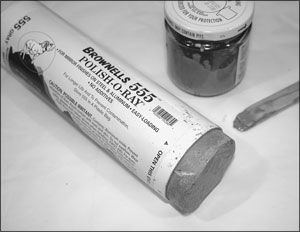
300
Well, it’s not exactly a solution. It’s more of a slurry. When it’s possible to disassemble the offending assembly, resolving a complaint about a trigger that’s “too rough” or “too heavy” is often simple. When disassembly has been made impossible, I’ve developed a technique I call “the slurry.” The technique works, and to some extent helps to defeat the gun manufacturers’ restrictive policies.
Here’s how “the slurry” works: You’ll need one each of Brownells 555 Black, 555 Gray, and 555 White polish. All are fine grit, the black being less fine than the gray, and the white being the finest of the three. You’ll need a quart of mineral spirits or K1 kerosene, a kitchen grater or serrated knife, three small jars with screw-on lids, paper towels, and a tongue depressor. Okay, got that? Now carefully scrape each bar of 555 until you have about three ounces of fine shavings from it on the napkin. Pour 1/4 ounce of mineral spirits into each jar, and add half of the black, gray, and white shavings, each into their own jar. Cap the jars and allow the compounds to soak up the solvent for an hour or two, stirring on occasion with the tongue depressor until there are no lumps and the consistency is like catsup. These mixtures can be individually fed into and extruded from a Brownells 10cc disposable syringe (#801-100-610AA). Which slurry you use first depends on how rough the trigger feels, but the gray followed by the white will usually do the job.
In the case of the Remington Model 105 CTi, refer to the photo and caption concerning points of cleaner application. Insert the tip of the syringe and push out a small amount on each surface or area indicated.
With the trigger mechanism out of the shotgun, switch the safety to “off.” Place your thumb over the hammer and pull the trigger. Control the hammer as it disengages the trigger to move to its fired position fully forward. Recock the trigger with the hammer and repeat. You’ll be repeating this 50 times or more as the slurry polishes the interior and critical engagement surfaces of the assembly. Afterwards, flush out the polish with solvent, air dry, and lightly lubricate the mechanism.
If you don’t like the 50-time manual operation of the trigger assembly as detailed above, there’s an alternative. You could charge the magazine with four, 12-gauge snap caps and then cycle the bolt and pull the trigger through at least 25 “rounds.” Better still, you could go to a trap range and have some fun.
The slurry has worked for me in many different situations. Recently, injecting it into a permanently enclosed rifle trigger smoothed up the trigger significantly. In another instance, the double-action pull of a law-enforcement duty pistol felt immeasurably lighter after a dab of the black mixture was applied to the upper mainspring strut, its seat in the hammer, and the strut itself. The owner of a lever-action Marlin believed the gun suffered from lagging lock time. It was easily sped up with the application of the gray slurry to the firing pin, firing-pin spring, and firing-pin tunnel within the bolt. And the White 555 slurry put a final, brilliant polish on the sear/hammer engagement surfaces of a M1911 trigger job I recently finished. In addition, I’ve found it unsurpassed for polishing the flats of small parts on a true surface. Of course, either snap caps or some other means of protecting firing pins—including their temporary removal—was taken each time the slurry was used.
As a final, comforting thought on this subject, the use of this technique is unlikely to result in voiding a factory warranty.

























